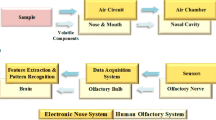Abstract
In this study, responses of a sensor array were employed to establish a quality index model able to describe the different picking date of peaches. The principal component regression (PCR) and partial least-squares regressions (PLS) model represent very good ability in describing the quality indices of the selected three sets of peaches in calibration and prediction. The results showed that the PLS model represents a good ability in predicting quality index, with high correlation coefficients (R = 0.86 for penetrating force [CF]; R = 0.83 for sugar content [SC]; R = 0.83 for pH) and relatively low standard error of prediction (SEP; 8.77 N, 0.299 °Brix, and 0.2 for CF, SC, and pH, respectively). The PCR model had high correlation coefficients (R = 0.84, 0.82, 0.78 for CF, SC, and pH, respectively) between predicted and measured values and a relatively low SEP (7.33 N, 0.44 °Brix, 0.21 for CF, SC, and pH, respectively) for prediction. These results prove that the electronic noses have the potential to assess fruit quality indices.






Similar content being viewed by others
References
Brezmes, J., Llobet, E., Vilanova, X., Saiz, G., & Correig, X. (2000). Fruit ripeness monitoring using an electronic nose. Sensors and Actuators B, 69, 223–229.
Brezmes, J., Llobet, E., Vilanova, X., Orts, J., Saiz, G., & Correig, X. (2001). Correlation between electronic nose signals and fruit quality indicators on shelf-life measurements with pinklady apples. Sensors and Actuators B, 80, 41–50.
Brezmes, J., Fructuoso, M. L. L., Llobet, E., Vilanova, X., Recasens, I., Orts, J., et al. (2005). Evaluation of an electronic nose to assess fruit ripeness. IEEE Sensors Journal, 5, 97–108.
Crisosto, C. H., & Crisosto, G. M. (2005). Relationship between ripe soluble solids concentration (RSSC) and consumer acceptance of high and low acid melting flesh peach and nectarine (Prunus persica (L.) Batsch) cultivars. Postharvest Biology and Technology, 38, 239–246.
Giusti, A. M., Bignetti, E., & Cannella, C. (2008). Exploring new frontiers in total food quality definition and assessment: from chemical to neurochemical properties. Food and Bioprocess Technology, 1, 130–142.
Gomez, A. H., Wang, J., Hu, G. X., & Pereira, A. G. (2006). Electronic nose technique potential monitoring mandarin maturity. Sensors and Actuators B, 113(1), 347–353.
Gomez, A. H., Wang, J., Hu, G. X., & Pereira, A. G. (2007). Discrimination of storage shelf-life for mandarin by electronic nose technique. LWT-Food Science and Technology, 40(4), 681–689.
Jarimopas, B., & Jaisin, N. (2008). An experimental machine vision system for sorting sweet tamarind. Journal of Food Engineering, 89, 291–297.
Malakou, A., & Nanos, G. D. (2005). A combination of hot water treatment and modified atmosphere packaging maintains quality of advanced maturity ‘Caldesi 2000’ nectarines and ‘Royal Glory’ peaches. Postharvest Biology and Technology, 38, 106–114.
Molto, E., Selfa, E., Ferriz, J., Conesa, E., & Gutierrez, A. (1999). An aroma sensor for assessing peach quality. Journal of Agricultural Engineering Research, 72, 311–316.
Natale, C. D., Macagnano, A., Martinelli, E., Paolesse, R., Proietti, E., & Damicro, A. (2001a). Electronic nose based investigation of the sensorial properties of peaches and nectarines. Sensors and Actuators B, 77, 561–566.
Natale, C. D., Macagnano, A., Martinelli, E., Paolesse, R., Proietti, E., & Damicro, A. (2001b). The evaluation of quality of post-harvest oranges and apples by means of an electronic nose. Sensors and Actuators B, 78, 26–31.
Natale, C. D., Zude-Sasse, M., Macagnano, A., Paolesse, R., Herold, B., & Damico, A. (2002). Outer product analysis of electronic nose and visible spectra: application to the measurement of peach fruit characteristics. Analytica Chimica Acta, 459, 107–117.
Neethirajan, S., Jayas, D. S., & Sadistap, S. (2009). Carbon dioxide (CO2) sensors for the agri-food industry—a review. Food and Bioprocess Technology, 2, 115–121.
Pathange, L. P., Mallikarjunan, P., Marini, R. P., Okeefe, S., & Vaughan, D. (2006). Non-destructive evaluation of apple maturity using an electronic nose system. Journal of Food Engineering, 77, 1018–1023.
Rodriguez-Nogales, J. M. (2006). Approach to the quantification of milk mixtures by partial least-squares, principal component and multiple linear regression techniques. Food Chemistry, 98, 782–789.
Saevels, S., Lammertyn, J., Berna, A. Z., Veraverbeke, E. A., Natale, C. D., & Nicolaı, B. M. (2003). Electronic nose as a non-destructive tool to evaluate the optimal harvest date of apples. Postharvest Biology and Technology, 30, 3–14.
Saevels, S., Lammertyn, J., Berna, A. Z., Veraverbeke, E. A., Natale, C. D., & Nicolai, B. M. (2004). An electronic nose and a mass spectrometry-based electronic nose for assessing apple quality during shelf life. Postharvest Biology and Technology, 31, 9–19.
Tan, E. S., Slaughter, D. C., & Thompson, J. F. (2005). Freeze damage detection in oranges using gas sensors. Postharvest Biology and Technology, 35, 177–182.
Wang, J., Teng, B., & Yu, Y. (2006). The firmness detection by excitation dynamic characteristics for peach. Food Control, 17, 353–358.
Wentzell, P. D., & Montoto, L. V. (2003). Comparison of principal components regression and partial least squares regression through generic simulations of complex mixtures. Chemometrics and Intelligent Laboratory Systems, 65, 257–279.
Acknowledgements
The authors acknowledge the financial support of the Chinese National Foundation of Nature and Science through project 30771246 and the National High Technology Research and Development Program of China through project 2006AA10Z212.
Author information
Authors and Affiliations
Corresponding author
Rights and permissions
About this article
Cite this article
Zhang, H., Wang, J., Ye, S. et al. Application of Electronic Nose and Statistical Analysis to Predict Quality Indices of Peach. Food Bioprocess Technol 5, 65–72 (2012). https://doi.org/10.1007/s11947-009-0295-7
Received:
Accepted:
Published:
Issue Date:
DOI: https://doi.org/10.1007/s11947-009-0295-7



